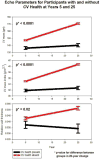Longitudinal determinants of left ventricular mass and geometry: the Coronary Artery Risk Development in Young Adults (CARDIA) Study
- PMID: 23922005
- PMCID: PMC3873157
- DOI: 10.1161/CIRCIMAGING.112.000450
Longitudinal determinants of left ventricular mass and geometry: the Coronary Artery Risk Development in Young Adults (CARDIA) Study
Abstract
Background: The purpose of this study was to identify determinants of 20-year change in left ventricular (LV) mass (LVM) and LV geometry in black and white young adults in the Coronary Artery Risk Development in Young Adults (CARDIA) Study.
Methods and results: We studied 2426 black and white men and women (54.7% white) aged 43 to 55 years with cardiovascular risk factor data and echocardiograms from CARDIA year 5 and 25 examinations. In regression models, year 25 LVM or relative wall thickness was the dependent variable and with year 5 echo values, age, sex, race, body mass index, change in body mass index, mean arterial blood pressure, change in mean blood pressure, heart rate, change in heart rate, tobacco use, presence of diabetes mellitus, alcohol use, and physical activity score as independent variables. LVM and relative wall thickness increased, whereas prevalence of normal geometry declined from 84.2% to 69.7%. Significant determinants of year 25 LVM/m(2.7) were year 5 LVM, year 5 and change in body mass index, year 5 and change in mean arterial pressure, year 5 and change in heart rate, baseline diabetes mellitus, and year 5 tobacco and alcohol use (overall r(2)=0.40). Significant determinants of year 25 relative LV wall thickness were year 5 value, black race, change in body mass index, year 5 and change in mean arterial pressure, starting smoking, and year 5 diabetes mellitus (overall r(2)=0.11).
Conclusions: Prevalence of abnormal LV hypertrophy and geometry increased from young adulthood to middle age. Both young adult cardiovascular risk traits and change in these traits predicted change in LV mass/geometry.
Keywords: blood pressure; echocardiography; left ventricular mass; obesity; risk assessment.
Figures


Comment in
-
Value and challenges of measuring left ventricular mass in clinical research: implications for the practitioner.Circ Cardiovasc Imaging. 2013 Sep;6(5):612-3. doi: 10.1161/CIRCIMAGING.113.000957. Circ Cardiovasc Imaging. 2013. PMID: 24046377 No abstract available.
References
-
- Urbina EM, Gidding SS, Bao W, Pickoff AS, Berdusis K, Berenson GS. Effect of body size, ponderosity, and blood pressure on left ventricular growth in children and young adults in the bogalusa heart study. Circulation. 1995;91:2400–2406. - PubMed
-
- Gardin JM, Brunner D, Schreiner PJ, Xie X, Reid CL, Ruth K, Bild DE, Gidding SS. Demographics and correlates of five-year change in echocardiographic left ventricular mass in young black and white adult men and women: The coronary artery risk development in young adults (cardia) study. J Am Coll Cardiol. 2002;40:529–535. - PubMed
-
- Gardin JM, Wagenknecht LE, Anton-Culver H, Flack J, Gidding S, Kurosaki T, Wong ND, Manolio TA. Relationship of cardiovascular risk factors to echocardiographic left ventricular mass in healthy young black and white adult men and women. The cardia study. Coronary artery risk development in young adults. Circulation. 1995;92:380–387. - PubMed
Publication types
MeSH terms
Grants and funding
LinkOut - more resources
Full Text Sources
Other Literature Sources
Medical

